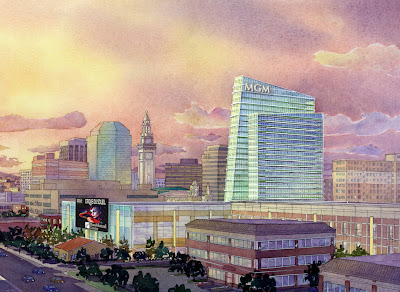 |
| Copyright Disney |
Santa Cruz Beach Boardwalk Announces Northern Calfiornia’s Only Spinning Coaster
 Santa Cruz, CA, USA (August 27, 2012) — The Santa Cruz Beach Boardwalk unveiled plans for a new $5.5M ride during a presentation for employees and media at the Boardwalk today.
Santa Cruz, CA, USA (August 27, 2012) — The Santa Cruz Beach Boardwalk unveiled plans for a new $5.5M ride during a presentation for employees and media at the Boardwalk today.
A new spinning roller coaster, named Undertow, will join the Boardwalk’s scream-worthy lineup of rides next summer. Manufactured by German coaster specialist Maurer Sohne, Undertow will be the only spinning coaster in Northern California.
“A spinning coaster is a very unique ride experience, we know our visitors are going to love it,” said Boardwalk community relations director Kris Reyes. “Every ride on Undertow is different, you can definitely expect the unexpected.”
Unlike most roller coasters, which carry an entire trainload of riders, Undertow uses individual cars each holding 4 riders, with each pair of riders facing opposite directions. The ride experience changes every time, depending on the weight and position of riders in the car.
Scheduled to open Summer 2013, Undertow will take over the location currently occupied by the Hurricane roller coaster. The Hurricane’s last day of operation is September 3; the ride has been sold to Western Playland Amusement Park in New Mexico.
The Boardwalk’s last major ride to open was the Haunted Castle, which opened in 2010.
For more information about Undertow, the Boardwalk’s new spinning roller coaster, visit http://www.beachboardwalk.com/undertow
About the Santa Cruz Beach Boardwalk
The historic Santa Cruz Beach Boardwalk features both modern and classic thrill rides, restaurants, miniature golf, video game arcades, and family bowling located on a mile of sandy beach. Named the world’s Best Seaside Amusement Park by industry experts, the Boardwalk is home to 2 National Historic Landmarks.
The Santa Cruz Beach Boardwalk is located at 400 Beach Street, Santa Cruz, CA 95060
www.beachboardwalk.com
Electrosonic Plants Interactive Technology at Brooklyn Botanic Garden
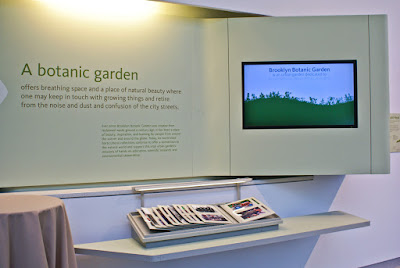 London, UK — With the opening of the Brooklyn Botanic Garden’s (BBG) new Visitor Center and gateway, visitors can now orient themselves to the garden, learn about its current blooms and plantings, and browse the event schedule via a series of interactives supported by Electrosonic for exhibit fabricator Hadley Exhibits.
London, UK — With the opening of the Brooklyn Botanic Garden’s (BBG) new Visitor Center and gateway, visitors can now orient themselves to the garden, learn about its current blooms and plantings, and browse the event schedule via a series of interactives supported by Electrosonic for exhibit fabricator Hadley Exhibits.
Founded in 1910, BBG is an independent, non-profit institution committed to education, science and horticultural display. BBG has served communities in New York City and around the world through its extraordinary gardens and living collections, and by pioneering educational and community programs. Situated on 52 acres in the heart of Brooklyn and originally laid out by the Olmstead Brothers landscape design firm, BBG is home to more than 12,000 types of plants and hosts more than 725,000 visitors annually.
The unique design of the new Visitor Center – a grass and tree-covered berm tucked into the natural setting – seamlessly melds architecture and landscape. The energy-efficient structure from the firm of Weiss/Manfredi features a glass wall, which stretches from the entryway to enclose the pavilion and house exhibition space where visitors access an array of interactive exhibits to get a feel for how to visit the BBG. Thinc Design was the exhibition designer for the new space.
Electrosonic faced numerous challenges in the Visitor Center. Working on a very tight schedule, the project required extensive coordination with Hadley Exhibits to ensure that all equipment fit smoothly and tightly inside wall-mounted and table-style interactives. Since the exhibits were designed to feature content that’s easily modified and updated, the AV components were selected to be flexible and easily maintained by BBG staff. For proper viewing of the content, Electrosonic also specified monitors offering optimum performance in the bright ambient light emitted by the new structure’s glass wall.
“The interior space is actually a window onto the gardens, so there’s a lot of ambient light streaming in and a lot of glare,” says Electrosonic account manager Bryan Abelowitz. “We revised our monitor selection to Samsung DX series high-brightness monitors, which have sensors that automatically adjust to light levels.”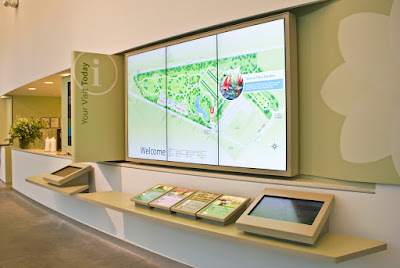
Visitors are welcomed by a three-screen interactive garden map depicting a graphical aerial layout of BBG, which will help them plan their visit. Electrosonic provided three ultra-narrow mullion Samsung UD55A displays to create one continuous map image. On a shelf beneath the wall-mounted map, a Dell interactive PC offering Links & Information resides alongside colorful printed info panels.
Adjacent to the map is a portrait-mode 46-inch Samsung LCD monitor displaying Today’s Events, an ever-changing roster of BBG happenings. A graphical Bloom Calendar is mounted perpendicular to the events schedule with another Dell interactive PC on the shelf below.
Two similarly-configured exhibits, one explaining BBG’s mission statement and the other tailored to update the frequent visitor, feature angled 40-inch Samsung LCD displays fed by Adtec signEdje HD MPEG media players triggered by motion sensors as visitors approach.
A portrait-mode 27-inch Samsung LED display with mount, which appears to float against the glass wall, features a video of BBG employees challenging visitors to a plant identification quiz. The display is fed by another Adtec signEdje HD MPEG player.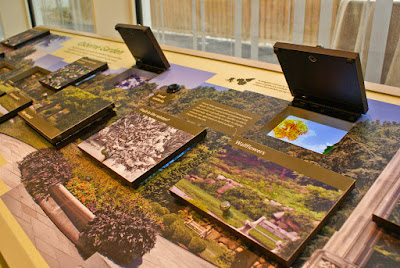
The most innovative interactives in the space are three peek-a-boo tables detailing different areas of the garden and how visitors can explore by using their senses. Hinged, three-dimensional photos of trees, plants and birds can be lifted by small knobs to reveal 6-inch LCD screens; short films about the image in the photograph begin to play when the hatches are lifted.
“Small, solid-state Technovision MPEG players in the tables are triggered by a magnetic switch built into the hinge,” says Abelowitz. Additional push buttons on the tables enable visitors to hear the sounds of the garden and sniff the fragrances of the blooms.
Electrosonic also provided a custom AMX control system to streamline operations and allow non-professionals to maintain efficient control of the system. BBG purchased a small back up roster of equipment, which Abelowitz calls “a very smart thing to do,” as the Visitor Center’s interactives experience daily wear and tear.
The control room is housed in the basement under the exhibit area. Two equipment racks are outfitted with source, control and monitoring equipment; centralized control allows for remote monitoring. Electrosonic furnished systems training for BBG staff and will be providing onsite maintenance and technical support for the first year of the Visitor Center’s operation.
“Electrosonic was wonderful — very attentive, very knowledgeable and willing to help. Everyone was great,” commented Sonal Bhatt, director of interpretation and exhibitions at Brooklyn Botanic Garden.
Richard Lewis Media Group designed the interactive content for the Visitor Center.
At Electrosonic, Ellen Simich was the project manager and Ed O’Connor project engineer.
Astronaut Neil Armstrong Dead at 82
 |
| Lunar Theater, Kennedy Space Center. Courtesy BRC Imagination Arts |
Cincinnati, OH, USA (August 25, 2012) — The family of Neil Armstrong, the first person to set foot on a celestial body, reports that he has passed away from “complications resulting from cardiovascular procedures.”
When Armstrong set foot on the moon on July 20, 1969, it marked the pinnacle of an effort which had begun with the deadly rocket program of the NAZI military and culminated in a single moment of peaceful accomplishment for the whole planet. The moon landing was broadcast live worldwide, including to guests at Disneyland who viewed it on a screen set up at the Tomorrowland Stage.
 |
| Apollo 11 landing live at Disneyland. Copyright Disney |
Armstrong’s achievement has been showcased in numerous exhibits, attractions, and films in the decades since, including the IMAX documentary Magnificent Desolation: Walking on the Moon and the BRC Imagination Arts-designed Lunar Theater at the Kennedy Space Center’s Apollo/Saturn V Visitor Center.
Muppet Legend Jerry Nelson Dead at 78
 Cape Cod, MA, USA (August 24, 2012) — Longtime Muppet performer Jerry Nelson passed away yesterday due to complications from cancer at his home on Cape Cod. Nelson started performing with Jim Henson in 1965, temporarily replacing Frank Oz as the right arm of Rowlf the Dog on the Jimmy Dean Show. Over the years, he performed and voiced a number of characters for both the Muppet and Sesame Street franchises and appeared as a human actor on Sesame Street.
Cape Cod, MA, USA (August 24, 2012) — Longtime Muppet performer Jerry Nelson passed away yesterday due to complications from cancer at his home on Cape Cod. Nelson started performing with Jim Henson in 1965, temporarily replacing Frank Oz as the right arm of Rowlf the Dog on the Jimmy Dean Show. Over the years, he performed and voiced a number of characters for both the Muppet and Sesame Street franchises and appeared as a human actor on Sesame Street.
As is often the case with the Muppets, Nelson would hand over roles to or pick up roles from others. Following the death of Richard Hunt, he played Statler, one half of the curmudgeon team of old men in the balcony, in four theatrical films. Nelson is credited as playing Camilla the chicken and Zoot the saxophone player in the Muppetvision 3D film showing at Disney theme parks.
Sesame Workshop, the producers of Sesame Street, have issued the following statement:
The cast and crew of Sesame Street and the staff of Sesame Workshop deeply mourn the loss of cast member and creator of dozens of Muppet characters, Jerry Nelson. A member of the Sesame Street family for more than 40 years, he will forever be in our hearts and remembered for the artistry in his puppetry, his music, and the laughter he brought to children worldwide through his portrayal of Count von Count, Herry Monster, Fat Blue, Sherlock Hemlock, the Amazing Mumford and many other beloved characters. We will miss his extraordinary spirit and the joy he brought to our Street.
Ron Fricke’s Samsara Opens Today in New York and Seattle
 New York, NY and Seattle, WA, USA (August 24, 2012) — Filmed over a period of five years in twenty-five countries on five continents, and shot on 70mm film, Samsara transports viewers to the varied worlds of sacred grounds, disaster zones, industrial complexes, and natural wonders. The film is being presented in 4K digital at two historic theaters – the Sunshine Cinema in New York and the Cinerama Theater in Seattle.
New York, NY and Seattle, WA, USA (August 24, 2012) — Filmed over a period of five years in twenty-five countries on five continents, and shot on 70mm film, Samsara transports viewers to the varied worlds of sacred grounds, disaster zones, industrial complexes, and natural wonders. The film is being presented in 4K digital at two historic theaters – the Sunshine Cinema in New York and the Cinerama Theater in Seattle.
Director Ron Fricke (Koyaanisqatsi, Chronos (IMAX), Baraka), along with longtime collaborators producer Mark Magidson, and composer Michael Stearns will attend question & answer sessions following the film on Friday evening in New York and Saturday evening in Seattle.
MGM Resorts Announces Plans to Revitalize Tornado Damaged Downtown Springfield, Mass
 Springfield, MA, USA /PRNewswire/ — MGM Resorts International’s Chairman and CEOJim Murren has unveiled plans to develop an $800 million world-class dining, retail and entertainment district on about 10 acres of land heavily damaged by the June 2011 tornado in Downtown Springfield.
Springfield, MA, USA /PRNewswire/ — MGM Resorts International’s Chairman and CEOJim Murren has unveiled plans to develop an $800 million world-class dining, retail and entertainment district on about 10 acres of land heavily damaged by the June 2011 tornado in Downtown Springfield.
MGM’s Springfield plan envisions a revived Main Street area with people walking along vibrant tree-lined streets overflowing with restaurant choices, a variety of shopping options for everyone in the family, an outdoor stage, movie theaters, a casino and hotel that all respect and feed off of the area’s existing iconic architecture. The concept for a central downtown retail and entertainment district also includes a pedestrian bridge between the MGM project and the MassMutual Center.
The announcement came as MGM submitted its $400,000 application fee to the Massachusetts Gaming Commission (MGC). The non-refundable application fee will go to both the Commonwealth of Massachusetts and the City of Springfield to fund the vetting and negotiating process that MGM hopes will result in a world-class destination resort in Springfield.
While the new Massachusetts gaming law does not require that the application fee be submitted until later this year when the first MGC filing is due, MGM issued its check early, along with its certification of intent to apply, as a good faith sign of MGM’s commitment to Springfield.
Murren said, “We believe this is a significant demonstration of our desire to partner with Springfield and it gives the MGC and the city the resources they need to move forward during this groundbreaking phase for a new industry in Massachusetts.”
The MGM Springfield project would be developed on three city blocks located just 200 feet off Interstate 91, a popular North/South connector running from Connecticut to Vermont, only a few miles from the Massachusetts Turnpike. The blocks, where the devastation from last year’s tornado is still visible today, run between Union and State streets, and Columbus Avenue and Main Street. MGM controls several land parcels in the proposed development area, with many others under contract.
MGM Springfield would create thousands of permanent direct jobs as well as more than 2,000 construction-related jobs and thousands of additional indirect jobs. MGM Springfield would generate millions in annual tax revenues.
Murren said, “Ours is a vision rooted in partnerships that would increase tourism by elevating the level of dining, retail and entertainment not only within the MGM project area but hopefully opening onto Main Street, throughout Downtown Springfield and into the rest of this great city.”
MGM is hoping to partner with the City of Springfield and others on this project to help rebuild and revitalize Downtown Springfield in the aftermath of the tornado that heavily damaged many Downtown Springfield buildings. Development plans include preserving much of the downtown’s architecture by repurposing the original MassMutual headquarters at the corner of State and Main streets as MGM offices and 73 State Street as the historical entrance to a modern MGM hotel.
Springfield, the region’s cultural epicenter on the Connecticut River, is home to world-class museums, the Basketball Hall of Fame, the Springfield Symphony, the MassMutual Center and several well-known academic institutions.
Murren announced MGM’s vision for an economic revival of Downtown Springfield at the MassMutual Center before a group of elected officials and civic, business and community leaders. The group also heard from Bill Hornbuckle, President MGM Springfield and MGM Resorts Chief Marketing Officer, before a lunch that included informal conversations with guests and members of MGM’s executive team.
Project Details
The more than half-million square foot mixed-used development project would include a 25-story 250-room hotel with world-class amenities including a spa, pool and roof deck; 89,000 square feet of gaming space; about 70,000 square feet of retail and restaurant space that would accommodate 15 shops and restaurants; and a multi-level parking garage.
Plans also envision an approximately 130,000 square-foot dining, retail and entertainment district, tentatively named Armory Square, and directly accessible from the garage parking. It would include about 25 dining and retail venues including a 12-screen cinema, bowling alley and outdoor stage, to be developed by Davenport Properties of Boston, MA, in partnership with MGM on land now occupied by the tornado-ravaged South End Community Center and Howard Street School. MGM in conjunction with Davenport hopes to be the successful bidder for those parcels when the city auctions them later this year.
Market Rate Rentals
MGM Springfield would also include 40,000 square feet of market-rate one and two bedroom apartments, new homes for the young professionals working in a revived downtown entertainment district.
Local Cultural Institutions
The pedestrian bridge between MGM Springfield and the MassMutual Center, at the corner of State and Main streets, is a direct-link concept that would allow visitors to easily use the MGM Springfield garage for events at the MMC. No indoor entertainment area is planned; instead MGM plans to partner with existing facilities such as the MassMutual Center, Symphony Hall, City Stage and local museums, to help drive traffic to these facilities to support current and cultivate increased tourism in the local economy. MGM’s vision is to jump start a new era of economic development in Springfield that will flow from the project out onto Main Street and into all parts of the downtown and city economy.
With immediate highway access from Interstate 91, the proposed site is perfectly located to avoid downtown transportation problems. The development calls for strategically located public parking in a covered garage no more than 200 feet from the highway.
Plans also envision a trolley service that would link the entertainment district to key downtown locations including Union Station and the many popular cultural facilities. MGM officials have had preliminary conversations with the Pioneer Valley Transit Authority regarding the creation of such a trolley system.
Community Meetings, New Office to Come
Murren, Hornbuckle and other members of the MGM executive team have been meeting with city officials, as well as community and business leaders. Last night, MGM hosted a neighborhood dinner to share the project vision and pledge its commitment to the proposed development and revitalization of the area. More meetings with local leaders are planned.
Hornbuckle said the company will soon open a downtown office so people can stop by to share information and thoughts as the community process gets under way. Community involvement is a key priority in every MGM development, he added, and essential to creating a successful, world-class retail and entertainment destination.
Website
MGM has launched a website for MGM Springfield. The website, www.mgmspringfield.com, was developed as a resource for local residents to learn more about the proposed project. The site features information and maps highlighting the proposed development area in Springfield, along with MGM company information, press releases, a Springfield “frequently asked questions” section, and a “contact us” option. There also is a link allowing people to easily “Share Your Thoughts.”
MGM in Massachusetts
MGM first announced in January that it was interested in a Western Massachusetts gaming license. After considering a Brimfield location, MGM sought a site that could accommodate a dynamic world-class entertainment complex.
About MGM Resorts International
MGM Resorts International (NYSE: MGM) is one of the world’s leading global hospitality companies, operating a peerless portfolio of destination resort brands, including Bellagio, MGM Grand, Mandalay Bay and The Mirage. In addition to its 51% interest in MGM China Holdings Limited, which owns the MGM Macau resort and casino, the Company has significant holdings in gaming, hospitality and entertainment, owns and operates 15 properties located in Nevada, Mississippi and Michigan, and has 50% investments in three other properties in Nevada and Illinois. One of those investments is CityCenter, an unprecedented urban resort destination on the Las Vegas Strip featuring its centerpiece ARIA Resort & Casino. Leveraging MGM Resorts’ unmatched amenities, the M life loyalty program delivers one-of-a-kind experiences, insider privileges and personalized rewards for guests at the Company’s renowned properties nationwide. Through its hospitality management subsidiary, the Company holds a growing number of development and management agreements for casino and non-casino resort projects around the world. MGM Resorts International supports responsible gaming and has implemented the American Gaming Association’s Code of Conduct for Responsible Gaming at its gaming properties. The Company has been honored with numerous awards and recognitions for its industry-leading Diversity Initiative, its community philanthropy programs and the Company’s commitment to sustainable development and operations.
The Participation Culture: What I learned from the Man (Burning Man)
IPM guest blogger George Wiktor is a creative executive with over 25 years of experience producing and project management of custom designed theme parks, world’s fair pavilions, and cultural and educational complexes. He is president of The GW Group, and a past president of the Themed Entertainment Association. George’s first visit to Burning Man, motivated by curiosity and research, turned him into a dedicated “Burner” and annual citizen of Black Rock City.
The bright glowing circle of fire spins in the darkness drawing me through the desert. Nearing, I see a gathering of people watching, embers washing over them. They stare into the circle of fire and sway to the rhythms of the nearby Art Car. In the inferno, logs tumble through the Firewheel. People dressed in orange coveralls tend the fire and spin the wheel. It’s here that I finally make my connection with The Man.
 |
| Photos: George Wiktor and Burning Man. (c) all rights reserved |
It’s been three days. I am in total overload. But I have not yet connected. I have, however, been thinking about this moment – my first visit to Burning Man – for five years. I prepared for six weeks. Read the survival guide. Surfed the bulletin boards. Bought the essentials. I even have vinegar water in a spray bottle to neutralize the caustic effect of the alkaline plain we are calling home for these few days.
| Photos: George Wiktor and Burning Man. (c) all rights reserved. |
For those of you who may have been living under a rock for the last quarter century, Burning Man is not any old arts festival, nor is it a Renaissance Faire for the counterculture. It is, in fact, THE art festival and a community that rises out of the Nevada desert for a week. Fifty-thousand people gather, camp in extreme conditions, and create a participatory, cross-cultural, gifting, open society. What’s going on here? Is this, perhaps a lens into the future of group entertainment? Is this the themed experience model of the future?
For designers and producers in the Experience industry, it’s part of the brief to explore the intersection of the culture of today and tomorrow, and the future of entertainment. How does today’s audience want to experience shows, events and theme parks? More importantly, how does being a citizen of the digital age impact audience expectations? Does living in the digital age demand a totally new style of entertainment? Is technology a key ingredient? Has there been a paradigm shift, and if so, can we define it?
“For designers and producers in the Experience industry, it’s part of the brief to explore the intersection of the culture of today and tomorrow, and the future of entertainment.”
 |
| Photos: George Wiktor and Burning Man. (c) all rights reserved. |
This “Participation Culture” is one of the key differentiators. Beyond technology. Beyond interactivity. Beyond clever media delivery. Beyond 4D immersive shows and environments. We now have participants in entertainment creating that entertainment for themselves. More participants means more entertainment as well as more varied entertainment.
 |
| Photos: George Wiktor and Burning Man. (c) all rights reserved. |
Burning Man has a reputation of being a free-for-all; with drugs, nudity, anarchy, and an anything-goes attitude. But seen first-hand, it turns out to be a highly structured, well-organized, law abiding, civil society: A society that encourages self expression and self reliance in an incredibly inhospitable physical environment. Commercial activity is prohibited and, refreshingly, there are no corporate sponsors. The place operates on gifting with no expectation of return.
And most importantly, participation is the key to the success of this event because participation is a form of gifting. Everyone is focused on adding to the success of everyone else’s experience. Whether it be creating an art installation, volunteering in the café, building a lounge in your camp, or providing entertainment for everyone, all the participants add to the overall experience.
The Firewheel is a perfect example. A group of individuals came together to conceptualize and execute a complex art and entertainment installation. Each night they gathered and for many hours operated this primitive and literal fireworks display. Why? Well… for no other reason than to provide visual delight to their fellow Burners, to participate on a grand scale, and to add to the overall success of this extravagant event.
Over the last 25 years, Burning Man has evolved and today it stands as one of the prime examples of the online Participation Culture that feeds into the real world. Those of us creating entertainment as well as reality-based information attractions need to understand this. As we create and develop places that look to attract today’s and tomorrow’s audiences, we need to focus on our audience’s fundamental need to participate.
| Photos: George Wiktor and Burning Man. (c) all rights reserved. |
We need to create infrastructure-based attractions that encourage creative participation. Such attractions change over time, as a result of the direct participation of our audience. Who knows where the participation will lead? In our world, perhaps we should be designing attractions that evolve through the course of a day. Each night they re-set to zero and the cycle of participation begins again.
This is a revised version of an article that first appeared in the TEA Annual & Directory, published by the Themed Entertainment Association. Reprinted with permission.
For the official Burning Man survival guide, visit this link.
WhiteWater Acquires Hopkins Rides
 |
|
The new Pirate Reef ride atLEGOLAND® California Resort is a Hopkins ride. Photo credit: LEGOLAND® California Resort |
Richmond, BC (August 23, 2012) – WhiteWater is pleased to announce that Hopkins Rides (formerly O.D. Hopkins) has joined the WhiteWater family of companies. Hopkins Rides will continue to operate under the same name and will continue to offer its legendary amusement park attractions: the Log Flume Ride, Super Flume, Shoot the Chute, River Raft Ride, as well as other water transportation systems.
Teri Ruffley, Managing Director of WhiteWater’s amusement ride section says, “Having Hopkins Rides on board advances our mission to bring to market the most exciting and diverse aquatic amusement park attractions portfolio in the world. We are positioned for and looking forward to a strong year ahead in this segment of the industry.”
“We’re ecstatic to be part of WhiteWater,” says Jim Glover, who continues as the Director of Sales for Hopkins Rides. “We also believe Hopkins’ rides will offer high capacity additions to world-class waterparks.”
“Our vision is to bring in originals like Hopkins Rides to reinforce what WhiteWater does best – top-notch attractions”, says Geoff Chutter, WhiteWater President & CEO. “And stay tuned… because we have many more originals coming down the line.”
Hopkins Rides began in 1979 and has continued to deliver highly popular water-based rides for the amusement park sector. Hopkins Rides is based out of Palm City, Florida and joins WhiteWater as its 19th global office. For information on Hopkins Rides, The Waterflow Experts, please visit www.hopkinsrides.com.
For more information on WhiteWater West Industries, visit www.whitewaterwest.com.
Theme Park Bill On Way to Senate Vote in US Virgin Islands
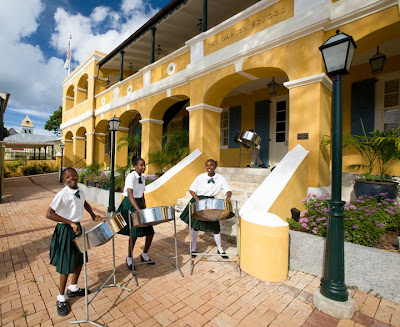 |
| St. Croix. Courtesy Office of the Commissioner of Tourism, US Virgin Islands |
St. Thomas, US Virgin Islands (August 23, 2012) — On Monday, the Senate Rules Committee passed a bill authorizing proposals for a theme park on the island of St Croix. The bill now goes to the full Senate.
The bill would authorize the Public Finance Authority to solicit proposals for the development and construction of a water and adventure park on the island of St. Croix. The Bill was sponsored by Senator Nereida Rivera-O’Reilly.
David W. Mapp, from the Virgin Islands Port Authority (VIPA), in his testimony during an earlier hearing before the Committee on Economic Development, Technology and Agriculture, said he supports the Bill as outlined. He said in 2001 the VIPA commissioned a TRIAD report, a document that outlined and recommended an economic development action plan specifically for the island of St. Croix. The plan identified the construction of a cultural theme park, as well as an aquarium as key pieces in the establishment of the St. Croix branding specific for the purpose of a new tourism market development tool.
Mapp said after an extensive market and economic analysis, a site evaluation study and finally a week-long design charette, the “Ay Ay” Cultural Theme Park, originally proposed in 2004, was conceived, with a proposed primary placement on the western end of the island. He further noted that this proposed development incorporated the TRIAD recommended aquarium, various rides and cultural elements from local foods to music, which would provide visitors with both an educational as well as a theme park experience, and in short, a mini Epcot Center in this part of the Caribbean.
According to Mapp, it remains his agency’s position that while such a development is but one part of the ‘hub and spoke’ required to re-invent the St. Croix brand in this highly competitive tourism market. He added that it would be a significant step in the right direction towards increasing airlift, hotel rooms and cruise calls to the island of St. Croix.
Commissioner of Tourism Beverly Doty testified before the earlier Committee that her department is encouraged by the many efforts being made to develop ideas to improve tourism product and thus make the US Virgin Islands a more competitive travel destination.
She said that any new water or adventure park would be beneficial to the territory by establishing a theme that’s consistent with the unique culture, heritage and beauty of the island of St. Croix.



